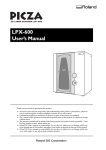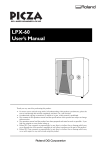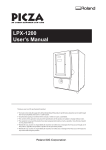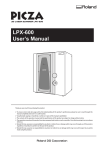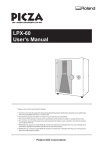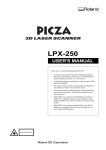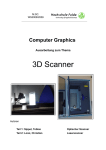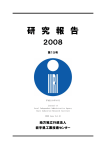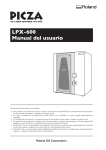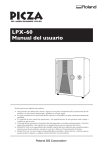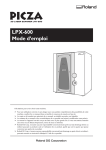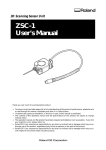Download Roland PICZA LPX-1200 User's Manual
Transcript
LPX-1200
User’s Manual
Thank you very much for purchasing this product.
• To ensure correct and safe usage with a full understanding of this product's performance, please be sure to read
through this manual completely and store it in a safe location.
• Unauthorized copying or transferral of this manual, in whole or in part, is prohibited.
• The contents of this operation manual and the specifications of this product are subject to change without notice.
• The operation manual and the product have been prepared and tested as much as possible. If you find any misprint or error, please inform us.
• Roland DG Corp. assumes no responsibility for any direct or indirect loss or damage which may occur through
use of this product, regardless of any failure to perform on the part of this product.
• Roland DG Corp. assumes no responsibility for any direct or indirect loss or damage which may occur with
respect to any article made using this product.
For the USA
FEDERAL COMMUNICATIONS COMMISSION
RADIO FREQUENCY INTERFERENCE
STATEMENT
This equipment has been tested and found to comply with the
limits for a Class A digital device, pursuant to Part 15 of the
FCC Rules.
These limits are designed to provide reasonable protection
against harmful interference when the equipment is operated
in a commercial environment.
This equipment generates, uses, and can radiate radio
frequency energy and, if not installed and used in accordance
with the instruction manual, may cause harmful interference
to radio communications.
Operation of this equipment in a residential area is likely to
cause harmful interference in which case the user will be
required to correct the interference at his own expense.
Unauthorized changes or modification to this system can void
the users authority to operate this equipment.
The I/O cables between this equipment and the computing
device must be shielded.
For Canada
CLASS A
NOTICE
This Class A digital apparatus meets all requirements of the
Canadian Interference-Causing Equipment Regulations.
CLASSE A
AVIS
Cet appareil numérique de la classe A respecte toutes les
exigences du Règlement sur le matériel brouilleur du
Canada.
ROLAND DG CORPORATION
1-6-4 Shinmiyakoda, Hamamatsu-shi, Shizuoka-ken, JAPAN 431-2103
MODEL NAME
: See the MODEL given on the rating plate.
RELEVANT DIRECTIVE : EC LOW VOLTAGE DIRECTIVE (73/23/EEC)
EC ELECTROMAGNETIC COMPATIBILITY DIRECTIVE (89/336/EEC)
This system (including the housing and safety device) is a Class 1 laser product.
Laser specifications of this system (including the housing)
Wavelength: 645 to 660 nm, maximum output: less than 0.39 µW
Complied with IEC/EN Publication 60825-1, Amendment 2, 2001.
Complies with 21 CFR 1040.10 and 1040.11 except for deviations pursuant to Laser Notice No.50, dated July 26, 2001.
CAUTION
Use of controls or adjustments or performance of procedures other than those specified herein may result in radiation exposure.
To Ensure Safe Use
Be sure to read this chapter before use. It contains important notes for using this machine safely. Be sure to
observe the notes when using the machine.
This manual uses the following notation for important notes on using the machine safely.
About
and
Notices
Used for instructions intended to alert the user to the risk of death or
severe injury should the unit be used improperly.
Used for instructions intended to alert the user to the risk of injury or
material damage should the unit be used improperly.
* Material damage refers to damage or other adverse effects caused
with respect to the home and all its furnishings, as well to domestic
animals or pets.
About the Symbols
The
symbol alerts the user to items that must never be carried out (are forbidden).
The specific thing that must not be done is indicated by the design contained within the
circle. The symbol at left means the unit must never be disassembled.
The
symbol alerts the user to things that must be carried out. The specific thing that
must be done is indicated by the design contained within the circle. The symbol at left
means the power-cord plug must be unplugged from the outlet.
About the Power Supply
Do not use with any electrical power supply that does not meet the ratings displayed on the AC adapter.
Use with any other power supply may lead
to fire or electrocution.
Do not use with any power supply other
than the dedicated AC adapter.
Use with any other power supply may lead
to fire or electrocution.
Use only with the power cord included
with this product.
Use with other than the included power cord
may lead to fire or electrocution.
Operation and Handling
Do not disassemble, repair, or modify.
Doing so may lead to fire or abnormal operation resulting in injury.
Do not use while in an abnormal state
(i.e., emitting smoke, burning odor, unusual noise, or the like).
Doing so may result in fire or electrocution.
Immediately unplug the power-cord plug
from the electrical outlet, and contact your
authorized Roland DG Corp. dealer or service center.
1
About the Power Supply
Do not use with a damaged AC adapter,
power cord, or power-cord plug, or with
a loose electrical outlet.
Doing so may lead to
fire, electrical shock,
or electrocution.
Do not attempt to unplug the power-cord
plug with wet hands.
Doing so may result
in electrical shock
or electrocution.
Do not damage or modify the electrical
power cord, subject it to excessive bending, twisting, pulling, binding, or pinching, or place any object or weight on it.
Doing so may damage the electrical
power cord, leading to fire, electrical shock, or electrocution.
When unplugging the electrical power
cord from the power outlet, grasp the
plug, not the cord.
Unplugging by pulling the cord may
damage it, leading to
fire, electrical shock,
or electrocution.
Operation and Handling
Lifting and carrying are operations that
must be carried out by two persons, by
grasping the bottom of the machine.
Failing to do so may result in injury.
Securely fasten the object to be scanned
to the table so that it does not slip or
topple over.
The table rotates during scanning. Tipover
or contact by the scan object may cause damage. Scan-object damage is not covered by
warranty.
Do not use if the housing or window area
is cracked or deformed.
In such cases, there is danger of external
emission of Class 3R laser light. Staring at
externally emitted laser light may cause eye
injury.
Do not insert metal objects, flammable
objects, or any other foreign object into
interior areas other than the top of the
table. Also, do not place water or other
liquids on any area, including the table.
Doing so may cause fire.
Never try to scan an object whose height
is 206.3 mm or more, or that protrudes
beyond the table.
The object may strike the interior of the machine, causing breakdown or damage. The
scan object may also be damaged. Scan-object damage is not covered by warranty.
About the Installation Site
When not in use for several hours, unplug the power-cord plug from the electrical outlet.
Failure to do so may result in danger of electrical shock, electrocution,
or fire due to deterioration of electrical insulation.
2
Install on a stable surface.
Failure to do so may
result in the unit tipping over, leading to
injury.
About the Labels Affixed to the AC Adaptor and Unit
Front
AC Adaptor
Rating label
Use a rated power supply.
In addition to these symbols, the symbol shown below is also used.
: Indicates a handy tip or advice regarding use.
3
Usage Cautions
About the Installation Site
Use the machine in an operating environment that meets the following conditions.
Temperature: 10 to 40ºC (50 to 104ºF) [25ºC (77ºF) or more recommended]
Humidity: 35 to 80% (no condensation)
Never use the machine in any of the following situations.
• Places with excessive humidity or dust.
• Places subject to high temperature.
• Places with excessive vibration.
• Places with electrical noise.
• Places with poor heat dissipation.
Operation and Handling
Be sure to remove the head retainer before use.
Failure to remove it may cause breakdown.
Never subject the machine to impact during a scanning operation.
Doing so may cause scanning noise.
Except in an emergency, never open the machine's door during a scanning operation.
Doing so switches off the power, and scanning operation cannot be resumed.
Never touch any internal component except the table.
Doing so may make scanning impossible.
Connect the AC adapter and USB cable securely so that they do not come loose or experience faulty
connection during use.
Failure to do so may make scanning impossible.
Use a shielded USB cable having a length of three meters or less. Never use a USB hub or the like.
Failure to do so may make scanning impossible.
Important Cautions Regarding Laser Light
This machine uses a laser beam to scan objects, but dangerous laser radiation is not emitted outside the machine. It is
safe to view the laser light through the window.
However, this may not be the case if the machine is disassembled or if its cover or safety devices are broken or disabled.
Please observe the cautionary notes in this documentation and never attempt to use this machine if the machine is in an
abnormal state.
Direct contact with the laser beam will not cause burns or fire due to incorrect use or the like. The natural blink reflex
protects the eye in the event that laser light from the machine directly enters the eye, but staring directly into the laser
beam may result in eye injury.
Items That may Not Be Copied
Unauthorized reproduction of a copyrighted item for any purpose other than personal use may be a violation of copyright. Roland DG Corp. will not be responsible for any violation of third-party copyright by any article made through
use of this product.
4
Table of Contents
To Ensure Safe Use ............................................................................................................................... 1
About the Labels Affixed to the AC Adaptor and Unit .......................................................................................................................... 3
Usage Cautions ..................................................................................................................................... 4
Table of Contents ................................................................................................................................... 5
What Is the LPX-1200? ......................................................................................................................... 7
Features .................................................................................................................................................................................................... 7
Scanning System ...................................................................................................................................................................................... 7
About the Documentation ...................................................................................................................... 8
Names and Functions ............................................................................................................................ 9
1. Preparing the Machine .............................................................................................. 11
1-1 Checking Accessaries ................................................................................................................... 12
1-2 Installing ........................................................................................................................................ 13
Installation Environment ....................................................................................................................................................................... 13
Removing the Protective Material ........................................................................................................................................................ 14
Connecting the Power Cable ................................................................................................................................................................. 15
1-3 Installing and Setting Up the Software .......................................................................................... 16
Installing the Driver ............................................................................................................................................................................... 16
What to Do If Installation Is Impossible ............................................................................................................................................... 22
Installing the Programs .......................................................................................................................................................................... 24
Making the Settings for Using Dr.PICZA3 .......................................................................................................................................... 25
2. Creating 3D Data ........................................................................................................ 27
2-1 Task Flow ....................................................................................................................................... 28
2-2 Mounting the Scan Object ............................................................................................................. 29
Preparing the Scan Object ..................................................................................................................................................................... 29
Mounting the Scan Object ..................................................................................................................................................................... 31
2-3 Performing Scanning ..................................................................................................................... 32
Basic Scanning ....................................................................................................................................................................................... 32
Checking the Scanning Results ............................................................................................................................................................. 35
2-4 Finishing the Data ......................................................................................................................... 36
Selecting and Scanning a Specific Area ................................................................................................................................................ 36
Creating New Polygons ......................................................................................................................................................................... 40
2-5 Saving and Exporting Data ........................................................................................................... 41
Saving Data ............................................................................................................................................................................................ 41
Exporting Data ....................................................................................................................................................................................... 41
5
3. Editing Scanning Results - Using 3D Editor ........................................................... 43
3-1 What You Can Do Using 3D Editor ............................................................................................... 44
3-2 Importing and Exporting Data ....................................................................................................... 45
Importing Scanning Results Immediately ............................................................................................................................................. 45
Importing and Exporting ....................................................................................................................................................................... 45
Importing More Than One Set of Data ................................................................................................................................................. 45
3-3 Basic Operations for Objects ........................................................................................................ 46
How to View the 3D Editor Window .................................................................................................................................................... 46
Let's Try Editing Data with 3D Editor .................................................................................................................................................. 47
4. What to Do If... ............................................................................................................ 51
4-1 What to Do If... .............................................................................................................................. 52
4-2 When Moving the Machine ............................................................................................................ 53
5. Appendix ..................................................................................................................... 55
5-1 Specifications ................................................................................................................................ 56
Machine Specifications ......................................................................................................................................................................... 56
System Requirements for the Software ................................................................................................................................................. 56
System Requirements for USB Connection .......................................................................................................................................... 56
5-2 Table Dimensional Drawing ........................................................................................................... 57
Windows® and Windows NT® are registered trademarks or trademarks of Microsoft® Corporation in the United States and/or other countries.
Pentium is registered trademark of Intel Corporation in the United States.
Other company names and product names are trademarks or registered trademarks of their respective holders.
Copyright© 2004 Roland DG Corporation
6
http://www.rolanddg.com/
What Is the LPX-1200?
Features
The LPX-1200 is a three-dimensional (3D) scanner that uses a noncontacting laser method to scan the shape of solid
objects.
Noncontacting Laser System for Fast, Dependable Scanning
You can perform scanning without contact with the scan object, using a laser beam. This enables high-speed scanning
without the worry of damage to the object.
Support for Two Scanning Modes
Using the included Dr. PICZA3 program lets you perform scanning in either of two modes: plane scan or rotary scan.
You can choose the scanning mode that matches the shape of the scan object. By combining the two modes, you can
even scan objects with complex shapes.
A Wide Array of Scanning Functions
In addition to the two basic scanning modes, line-segment and point scanning functions are also supported. By using Dr.
PICZA3, you can extract the data for just the characteristic line segments (such as contour lines) and points of an object.
Using this as auxiliary data for three-dimensional modeling operations using CAD or computer-graphics programs
makes it possible to reduce the time and effort of modeling operations.
Scanning System
The LPX-1200 scans objects using laser light. It emits a spot beam onto the scan object and detects reflected light from
the object with sensors.
Laser emitter
Sensor
It performs scanning as it rotates the scan object and moves the laser beam from bottom to top.
Rotating table
7
About the Documentation
This machine comes with the following documentation.
User's Manual (this document)
Read this first. It contains important notes and cautions on usage, as well describing scanning methods, what to do in the
event of a problem, and other information.
Dr.PICZA3 Online Help
3D Editor Online Help
You view this documentation on your computer screen. Installing the program enables you to view the documentation.
☞ See "1-3 Installing and Setting Up the Software."
It provides detailed descriptions of the commands you use for each of the programs.
You can use either of two methods to view the documentation.
• From the [Start] Menu in Windows
From the [Start] menu, choose [All programs (or Programs)], then [Roland Dr.PICZA3 (Roland 3D Editor)], then
[Dr.PICZA3 (3D Editor) Help].
• Clicking the Help Menu in the Program
From the [Help] menu, click [Contents].
8
Names and Functions
Front
Door
When performing scanning, be sure to close
this. The power cannot be switched on while
the door is open. Opening the door while the
power is on switches off the machine.
Table
This is the base where you place objects
to be scanned. It rotates during scanning.
Never touch any internal area other than
the table.
Interlock switch
This is one of the safety devices. Never
insert any objects here. Doing so may keep
the door open and prevent the safety devices from working properly.
Movement lights
These are arranged in a ring around the
power button. They flash when the machine is performing some operation.
Power button
This switches the power on and off. To
switch on the power, you press this button. To switch off the power, you hold it
down for one second or longer. The color
of the light indicates the status of the machine.
Rear
USB connector
This connects a USB cable (sold separately).
AC adapter jack
This connects the AC adapter.
9
About the Indicator Lights
The lighted state of the power button and the movement lights tells you the status of the LPX-1200.
Indicator lights
Power button
Movement lights
The status of the LPX-1200
Dark
Dark
The power is off.
Lit (blue)
Flashing two at a time
Initialization is in progress.
Lit (blue)
Dark
Scanning is possible.
Lit (blue)
Flashing one at a time
Scanning is in progress.
Lit or flashing (blue and red) (*)
Lit or flashing (red)
Dark
☞ See "4-1 What to do if..."
An error has occurred.
(*)Illumination pattern (blue and red)
Red
Blue
Status Indicated by the Movement Lights
These light up blue and move clockwise two at a time during initialization at powerup, and one at a time during scanning.
Initialization
Flashing two at a time
Flashing one at a time
Move clockwise
Move clockwise
Scanning
When you open or close the door after connecting the power cable to the machine, the power button and movement lights flash
momentarily, but this is normal and does not indicate a problem.
10
1. Preparing the Machine
This section describes what to do when you first open the packing, including how to connect the machine to a computer and install the programs and the like.
11
1-1 Checking Accessaries
The following items are packed with the machine. Make sure they are all present and accounted for.
12
AC adaptor: 1
Power cord: 1
Clay: 1
CD-ROM: 1
User's Manual: 1
Roland Pixform Pro: 1
1. Preparing the Machine
1-2 Installing
Installation Environment
Place in a level, stable location.
1. Preparing the Machine
13
1-2 Installing
Removing the Protective Material
Open the door and remove the protective material.
Back of the door
Peel off the tape and remove the packing.
Packing
Peel off the tape.
Packing
Packing
Inside the door
Remove the head retainer. Unscrew the screws by hand.
Screw
Head retainer
Screw
Never touch or try to move and internal equipment other than the head retainer and the screws.
The head retainer and packing will be needed if you must repackage the product. Please do not throw them
away.
☞ See "4-2 When Moving the Machine."
14
1. Preparing the Machine
1-2 Installing
Connecting the Power Cable
Connect the power cord and the AC adapter.
The rear of the machine
AC adaptor jack
AC adaptor
Power cord
When you connect the power cable to the machine, the power button and movement lights flash momentarily, but this is normal
and does not indicate a problem.
1. Preparing the Machine
15
1-3 Installing and Setting Up the Software
Here you connect the machine to your computer and install and set up the included software on the computer, enabling
you to perform scanning with the machine.
Installing the Driver
Connect the machine to the computer and install the driver.
Be sure to follow this procedure to install the driver. Failure to do so may make installation impossible.
☞ Go to "1-3 Installing and Setting Up the Software," see "What to Do If Installation Is Impossible."
Procedure
Windows XP
1
Start Windows and log on as "Administrator."
2
Insert the Roland Software Package CD-ROM
into the CD-ROM drive.
The setup menu appears automatically.
3
Switch on the machine.
Press the power button.
Wait a short while until the light stops flashing.
The flashing continues for about one minute.
From this point on, keep the machine's door closed
until installation ends. Failure to do so switches off
the power, which may prevent installation from completing correctly.
4
Connect a USB cable (sold separately).
The [Found New Hardware Wizard] dialog appears.
These lights flash clockwise two at a time.
USB connector USB cable
Computer
The rear of
the machine
USB port
16
1. Preparing the Machine
1-3 Installing and Setting Up the Software
5
Choose [Install the software automatically], then
click [Next].
6
When this window appears, click [Continue
Anyway].
Installation starts automatically.
7
Click [Finish].
8
Carry out steps 5 through 7 again.
The [Welcome to the Found New Hardware Wizard] dialog appears.
This completes the installation of the driver.
1. Preparing the Machine
17
1-3 Installing and Setting Up the Software
Windows 2000
1
Start Windows and log on as "Administrator."
2
Insert the Roland Software Package CD-ROM
into the CD-ROM drive.
The setup menu appears automatically.
3
Switch on the machine.
Wait a short while until the light stops flashing.
The flashing continues for about one minute.
Press the power button.
From this point on, keep the machine's door closed
until installation ends. Failure to do so switches off
the power, which may prevent installation from completing correctly.
These lights flash clockwise two at a time.
4
Connect a USB cable (sold separately).
The [Found New Hardware Wizard] dialog appears.
USB connector USB cable
Computer
The rear of
the machine
USB port
5
18
Click [Next].
1. Preparing the Machine
1-3 Installing and Setting Up the Software
6
Select [Search for a suitable driver for my device], then click [Next].
7
Select the [CD-ROM drives] check box, then
click [Next].
8
Click [Next].
9
Click [Finish].
10
Installation starts automatically.
The [Welcome to the Found New Hardware Wizard] dialog appears.
Carry out steps 5 through 9 again.
This completes the installation of the driver.
1. Preparing the Machine
19
1-3 Installing and Setting Up the Software
Windows Me/98
1
Start Windows.
2
Insert the Roland Software Package CD-ROM
into the CD-ROM drive.
The setup menu appears automatically.
3
Switch on the machine.
Wait a short while until the light stops flashing.
The flashing continues for about one minute.
Press the power button.
From this point on, keep the machine's door closed
until installation ends. Failure to do so switches off
the power, which may prevent installation from completing correctly.
These lights flash clockwise two at a time.
4
Connect a USB cable (sold separately).
The [Add New Hardware Wizard] dialog appears.
USB connector
USB cable
Computer
The rear of
the machine
USB port
5
20
Click [Next].
1. Preparing the Machine
1-3 Installing and Setting Up the Software
6
Choose [Search for the best driver for your device], then click [Next].
7
• Windows Me
Installation of the driver starts automatically.
• Windows 98
Choose the folder on the Roland Software
Package CD-ROM to search the driver.
3
Double-click on your CDROM drive.
4
1
8
Choose [Specify
a location].
2
Click the button.
Click [OK].
Execute installation of the driver.
Click [Next].
9
5
Choose
[\Drivers\LPX-1200].
Clicking this button starts
installing.
Click [Finish].
Installation is executed automatically.
This completes the installation of the driver.
1. Preparing the Machine
21
1-3 Installing and Setting Up the Software
What to Do If Installation Is Impossible
If installation quits partway through, or if the wizard does not appear when you connect the USB cable, take action as
follows.
Procedure
1
If the [Found New Hardware Wizard] dialog appears, click [Finish] to close it.
2
Display [Add or Remove Programs] (or [Add/Remove Programs]).
• Windows XP
From the [Start] menu, choose [Control Panel], then click [Add or Remove Programs].
• Windows 2000/Me/98
From the [Start] menu, choose [Settings], then [Control Panel], then click [Add/Remove Programs].
3
Uninstall [Roland LPX-1200 USB Device].
Click
Click
4
Detach the USB cable connected to the printer.
5
Restart Windows.
6
Follow the procedure in "Installing the Driver" to redo installation from the beginning.
If [Roland LPX-1200 USB Device] does not appear in the list, follow the steps below.
1
Display [System Properties].
• Windows XP
Click the [Start] menu, then right-click [My Computer]. Click [Properties].
• Windows 2000/Me/98
Right-click [My Computer] on the desktop. Click [Properties].
22
1. Preparing the Machine
Click
1-3 Installing and Setting Up the Software
2
Display [Device Manager].
• Windows XP/2000
Click the [Hardware] tab, then click [Device Manager].
1
Click the tab.
2
Click the button.
• Windows Me/98
Click [Device Manager].
3
Delete [LPX-1200].
• Windows XP/2000
3
1
2
Click this, then click
[Uninstall].
Double-click
this.
4
Click [OK].
Click this.
• Windows Me/98
1
Click this.
3
2
Click [OK].
Click the button.
4
Close the [Device Manager] dialog and click [OK].
5
Follow steps 4 through 6 on the previous page to redo installation from the beginning.
1. Preparing the Machine
23
1-3 Installing and Setting Up the Software
Installing the Programs
Install the following programs.
Dr.PICZA3
3D Editor
LPX Head Move
This program enables you to perform scanning using the machine.
This program enables you to edit scanned 3D data.
This program enables you to move the head to a fixed position when repacking the machine.
1
Make sure the screen shown in the figure is
displayed.
2
Follow the on-screen instructions to start installation and setup.
Select [LPX-1200].
Make sure that all the
boxes be checked.
3
When the screen shown in the figure appears,
click "Next." Thereafter, follow the on-screen
instructions.
When all installation and setup finishes, the final window appears.
4
Click [Close].
This completes the installation of the included software.
24
1. Preparing the Machine
Clicking the button
starts installing.
1-3 Installing and Setting Up the Software
Making the Settings for Using Dr.PICZA3
You use the included Dr. PICZA3 program to make the settings that let you perform scanning with the machine.
1
Start Dr.PICZA3.
2
Go to the [File] menu and click [Preferences].
3
Make the setting for the communication port and the unit of measurement to use with Dr. PICZA3.
From the [Start] menu, choose [All programs (or Programs)], then [Roland Dr.PICZA3], then [Dr.PICZA3].
Click this after you complete
making the setting.
Choose the number of the port
labeled "(Roland LPX-1200 USB
Port)."
Set [Units] to either [mm] or [inch].
This completes all the preparations you need to make to perform scanning using the machine.
1. Preparing the Machine
25
26
2. Creating 3D Data
This chapter describes how to create 3D data using the machine and
the included Dr. PICZA3 program.
27
2-1 Task Flow
This machine can scan three-dimensional shapes using the included Dr. PICZA3 program. To make 3D data obtained by
scanning available for use by other programs, you need to convert and save the data using Dr. PICZA3.
This section describes the sequence of operations from getting ready to scan through to saving the 3D data.
1
Prepare the object to be scanned and mount it on the machine.
Check whether the object you want to scan (we'll call this the "scan object") is suitable for scanning, and if so,
mount it on the machine.
☞ See "2-2 Mounting the Scan Object."
2
Perform scanning.
Use Dr. PICZA3 to carry out scanning (basic scanning).
☞ See "2-3 Performing Scanning."
3
Finish the data.
After the basic scanning, you finish the data to the appropriate degree by performing additional scanning and
creating polygon meshes as required.
☞ See "2-4 Finishing the Data."
4
Save the data.
Save the finished data in a file format compatible with the program you're using.
☞ See "2-5 Saving and Exporting Data."
Using the included 3D Editor program lets you import directly and edit data scanned with Dr. PICZA3.
☞ See "3. Editing Scanning Results -- Using 3D Editor."
28
2. Creating 3D Data
2-2 Mounting the Scan Object
First, you prepare the object to be scanned. After making sure the object is one that can be scanned, you mount the object
on the machine.
Preparing the Scan Object
This machine is not able to scan every possible kind of object. Some objects may be impossible to scan because of their
composition or shape. Refer to the following and make sure the object to be scanned is one that can be scanned on this
machine.
Object size
Never try to scan an object that protrudes beyond the table or whose size exceeds the scanning area.
Doing so may cause the machine to malfunction or damage the object to be scanned.
An object that protrudes beyond the table or whose height is too high cannot be scanned.
130 mm
No
206.2 mm
Table
In such cases, consider separating the object into pieces whose individual sizes do not protrude beyond the area described above.
Object shape
Areas where the laser beam strikes at a shallow angle cannot be scanned.
No
20 degrees or less
2. Creating 3D Data
29
2-2 Mounting the Scan Object
Object material
An object that has a comparatively smooth surface is suitable for scanning. Fabrics and objects that have a rough nap
cannot be scanned.
Yes
No
An object may be difficult to scan because of the type of material it is made of, or because of its color or other qualities.
Yes
Objects that do not pass
light
Yes Brightly colored objects
No
Clear or transparent
objects
No
(White, yellow, red, etc.)
Dark-colored objects
(black, blue, etc.)
Objects of a nonglossy
Yes material (plaster, wood, or
No
modeling clay etc.)
Glossy and highly reflective objects (metals,
mirrors, etc.)
In such cases, applying a surface coat (primer coat) to the object may make scanning possible.
(*) Avoid highly reflective objects because of danger of eye injury.
30
2. Creating 3D Data
2-2 Mounting the Scan Object
Mounting the Scan Object
Choose the object to be scanned, then mount the scan object.
Mount in the center of the table.
Secure the bottom surface
in place with clay or the like.
Table
Table centerline
The table rotates during scanning. Using double-sided tape, clay, or the like, fasten the object in place securely so that it
will not fall over or slip. Any slipping of the object makes correct scanning impossible.
When the object to be scanned has areas with cavities or voids, mounting the object at an orientation that allows the laser
beam to pass through the cavities, as shown in the figure, makes scanning easier.
Scan object
Orientation of
the laser beam
Cavity
Table
Orientation
of the laser
beam
Effective Sensor Area
The figure at right shows the area in which the machine's sensors
detect the reflection of the laser beam, allowing the object to be
scanned.
The surfaces that reflect laser light as the table rotates and the object passes through this area can be scanned.
When scanning an object that is considerably uneven, or that is
crank-shaped, you may need to take this effective sensor area into
account.
130 mm
203.2 mm
Effective Sensor
Area
3 mm
Table
30 mm
If the object is mounted at the edge of the table, it may not be
possible to scan the entire object correctly.
In the case of the apple shown at right, the area enclosed by the
shaded portion is not scanned.
Outside the effective
sensor area
Not reached by
the laser beam
2. Creating 3D Data
31
2-3 Performing Scanning
Once you have mounted the object of the machine, you can now perform scanning.
Before you start scanning, make sure the door is closed and turn on the machine.
Basic Scanning
This is the scanning that you perform first after mounting the scan object. The scanning data obtained by executing basic
scanning makes possible a wide variety of operations.
Procedure
1
Start Dr.PICZA3.
2
Click the [
3
Choose the scanning mode that matches the shape of the
scan object.
From the [Start] menu, choose [All programs (or Programs)], then [Roland
Dr.PICZA3], then [Dr.PICZA3].
] button.
The [Scan] dialog box appears.
Click one of these buttons.
The [Settings for Scanning] dialog box appears.
• Object whose shape is close to a sphere or cylinder
• Object with little unevenness
Choose rotary scanning.
• Other object
Choose plane scanning.
You normally choose plane scanning, which has little restrictions as to shape.
4
Click the [
] button.
The preview starts.
From this point on, never open the door until scanning ends. Doing
so switches off the power. Scanning cannot be resumed when you
then switch on the power again.
The general shape of The height of the
the object to be
scanning area is
scanned is displayed. setting automatically at this time.
Click
Preview in progress
32
2. Creating 3D Data
After preview has finished
2-3 Performing Scanning
5
While viewing the preview, make the following settings, then start scanning.
Scanning pitch
Using a fine setting can reproduce details more accurately, but the amount of memory required increases, and scanning takes
longer time.
Scanning area
Specify the minimum area that allows the entire object to be scanned, thereby speeding up scanning time.
(The following settings are only for plane scanning.)
The number of scanning surfaces
You can specify from one to as many as six surfaces. It's a good idea to decide on the number of surfaces to match the shape
of the object.
Scanning angle
Specify the incident angle of the laser for each surface. It may be a good idea to set the preview to Top View.
Setting screen for scanning (plane scan)
This changes to the surface
whose scanning angle you
want to set (plane scan only).
This sets the number of
scanning surfaces (plane
scan only).
This sets the scanning area.
During rotary scan, these set the
"Height Direction" and "Circumferential" pitch values.
This changes the orientation
and perspective for the preview.
These let you switch between Top
View and Front, and expand or
reduce the view.
This sets the scanning pitch.
During rotary scan, these make the
settings for "Height" and "Circumference."
6
This sets the scanning angle
(plane scan only).
This displays the amount of
memory that scanning requires.
Clicking the button displays the
estimated scanning time.
Clicking this button
starts scanning.
When scanning ends, the results of scanning appear.
☞ Go to "2-3 Performing Scanning" and see "Checking the Scanning Results."
2. Creating 3D Data
33
2-3 Performing Scanning
Scanning Pitch and Scanning Area
The methods for making the settings are different for plane scanning and rotary scanning.
Plane scan
Rotary scan
Width-direction pitch
Circumferential pitch
Last point
Heightdirection
pitch
Scanning
Height
Start point
Height-direction
pitch
0 degrees
circumferentially
Last point
Scanning Height
Start point
Scanning width
Required Memory
[Required Memory] at the lower right of the [Settings for Scanning] dialog box is automatically updated when you change the
scanning area or scanning pitch. When this amount of memory exceeds the amount of free memory on the computer, performing scanning may result in extremely slow processing by the computer. We recommend making sure enough memory is installed in the computer when you are performing scans that use up large amounts of memory.
For reference:
Maximum memory use
(amount of memory used when scanning at maximum scanning area and minimum scanning pitch)
Plane scan : 1148 Mbyte (per surface)
Rotary scan : 1767 Mbyte
34
2. Creating 3D Data
2-3 Performing Scanning
Checking the Scanning Results
You can examine the results of scanning while changing the view method and perspective. The Scan List displays a list
of scanning data. For detailed information about this window, see the online help for Dr. PICZA3.
These move and rotate the
perspective, and change the
amount of zoom.
This changes the view
method.
The three-dimensional
item that has been
scanned is called the
"object."
Drag the object to orient
the area you want to
examine to the front.
Dr.PICZA3 Window
This indicates the name of a
group that contains a number
of objects.
This switches between
showing and hiding the
group and the object.
This indicates the name of the
object.
Scan list
2. Creating 3D Data
35
2-4 Finishing the Data
You take the data from basic scanning and modify it to produce finished data that has the form you want.
Selecting and Scanning a Specific Area
After the basic scanning, you can select specific areas and performing additional scanning (rescanning). The available
types of rescanning are as follows.
Rescan
You use rescanning when you want to increase the number of measuring points (scan points) and enhance the degree of
completion of the 3D data.
Perform coarse scanning
of the entire object.
Rescan required
areas in detail.
You can reproduce detailed
surface patterns.
...you rescan
just these areas.
Even when holes are present...
The holes are sealed, yielding
the same shape as the original!
Line Scan/Point Scan
You use line scanning and point scanning when you want line-segment or point data to serve as supplemental data for
three-dimensional modeling operations using CAD or computer-graphics programs.
36
Perform line scanning with Dr.
PICZA3...
...and re-create the
curved surfaces with
the 3D CAD program!
Perform point scanning with Dr.
PICZA3...
...and re-create the
curves with the 3D
CAD program!
2. Creating 3D Data
2-4 Finishing the Data
Scanning Modes for Rescanning
You can choose the same scanning modes for rescanning and line scanning as you can for basic scanning.
• Scanning using plane scanning -- Plane rescan and plane line scan
• Scanning using rotary scanning -- Rotary rescan and rotary line scan
What follows is a general guide for using these selectively.
Rescan
• When you’re rescanning areas that could not be scanned
Normally you choose plane rescanning. When the scan object has a complex shape, it may be a good idea to use plane rescanning
to perform overlapping scanning, changing the angle between each scanning pass.
Note, however, that rescanning is not effective in cases where the laser beam cannot reach the area from any angle.
• When you’re rescanning a specific area at a fine scanning pitch
It may be a good idea to perform rescanning in the same mode you used for the basic scanning.
When you want to perform fine-detail scanning of the surface pattern of a scan object whose shape is cylindrical or close to
cylindrical, you first perform coarse rotary scanning, then choose rotary rescanning.
Line Scan
Normally you choose the same mode you used for basic scanning. However, when you want to scan line segments that wrap
around to the back of the object, you choose rotary line scanning. Plane line scanning can scan only line segments on the surface
visible in the window.
The entire circumference
can be scanned.
Rotary line scan
Only the line segment
shown by the thick line can
be scanned.
Plane line scan
To Use the Data with a 3D CAD Program or the Like
To use line-segment and point data as supplementary data for a 3D CAD program, you may need to export the data and convert
the file.
☞ See "2-5 Saving and Exporting Data."
2. Creating 3D Data
37
2-4 Finishing the Data
Procedure
You perform rescanning using the following procedure. The screens shown are those for plane rescanning.
1
First, scan the entire object.
Choose a scanning mode according to the shape of the
scan object.
From this point on, never open the door until
rescanning ends. Doing so switches off the power.
Scanning cannot be resumed when you then switch
on the power again.
You can speed up operations during basic scanning by
scanning at a coarse pitch. For line scanning and point
scanning in particular, it is a good idea to scan at the minimum pitch necessary to get the general shape.
2
When the scan of the entire object finished, click
the [
] button to choose the method you want
to use for rescanning.
3
Drag to specify the rescanning area.
You can specify more than one rescanning area.
Shortcut Keys for Shifting the Perspective
• To Rotate the Object
Hold down the SPACE key and drag
• To Move the Object
Hold down the Ctrl key and drag
• To expand and reduce the Object
Hold down the shift key and drag
SPACE key + drag left or right to shift
the perspective.
In addition to these shortcuts, you can also shift the perspective using the arrow keys. For detailed information,
refer to the online help for Dr.PICZA3.
Drag to specify the
rescanning area.
38
2. Creating 3D Data
2-4 Finishing the Data
4
Click the [
] button.
5
Drag to verify the area to rescan.
The mode for specifying the rescanning area is canceled.
The specified rescanning area is displayed as a three-dimensional form.
When you want to respecify the rescanning area, click the
object at any location to release the area already specified.
Specified rescanning area
6
Click the [
] button.
7
If necessary, change the scanning pitch, then
click [Scan].
The [Settings for Scanning] dialog box appears.
Here, none of the settings except for the scanning pitch
can be changed. It is also not possible to set a different
scanning pitch for each area.
Setting the Scanning Pitch
When performing rescanning, make the setting for the
scanning pitch as fine as possible. This increases the number of scanning points, enhancing the degree of completion. When little free memory is available, it may be a
good idea to use a narrow scanning area and perform
rescanning in several passes.
Rescanning
area
These set
scanning pitch.
This executes
rescanning.
You can perform rescanning as many times as you like after basic scanning. Also, when you want to redo scanning after
checking the scanning results, you can go back to the previous state before rescanning by clicking the [ ] button.
For detailed information on rescanning methods, refer to the online help for Dr. PICZA3.
2. Creating 3D Data
39
2-4 Finishing the Data
Creating New Polygons
You can create new polygons using all the scanning points, including the data produced by rescanning. These polygons
are called a "polygon mesh." Creating a polygon mesh can make it possible for you to reproduce cavities and voids in
the object and fill in holes according to the surrounding shape.
Creating a polygon mesh for
area of connected voids...
Creating a polygon mesh when
a hole has occurred ...
...deletes surfaces, reproducing
the void area of the original!
...lets you fill in the hole
simply and easily!
A polygon mesh is composed of polygons created by estimating the original shape of the scan object from the scanning
points. They differ from the polygons displayed immediately after scanning, which are generated simply by connecting
the scanning points.
Procedure
1
Click the [Create Polygon Mesh...] button.
The [Polygonization Options] dialog box appears.
[Create polygon mesh...] button
2
Select the parameters for creating a polygon
mesh, then click [OK].
For detailed information on the [Polygonization Options]
dialog box, refer to the online help for Dr. PICZA3.
3
If the polygon mesh is not what was intended,
change the parameters and create it again.
Tips for Creating a Polygon Mesh
To create a polygon mesh having a high degree of completion, you may need to scan at as fine a pitch as possible in order to
increase the number of scanning points. In particular, cases like those described below may yield a polygon mesh having a
configuration that is not what you intended.
• When there is a small number of scanning points with respect to undulations in the scan object
• When areas with holes are too big or the shape of them is complex
In such cases, rescan just that area at a fine pitch. When little memory is available on the computer, it may be a good idea to
divide the area into parts and repeat rescanning several times to increase the number of scanning points sufficiently, and then
create the polygon mesh.
☞ Go to "2-4 Finishing Data," see "Selecting and Scanning a Specific Area."
40
2. Creating 3D Data
2-5 Saving and Exporting Data
You can take data obtained by scanning and creating polygon meshes and save it in a file format compatible with Dr.
PICZA3. You can also convert (export) data and save it in a file format allowing import into other programs.
Saving Data
Go to the [File] menu and click [Save As]. The data is saved in Dr. PICZA project format (with the file extension .pij).
In addition to working with saved files with Dr. PICZA3, you can edit them using 3D Editor, an editing program for 3D
data.
Dr.PICZA project format
Scanning data
Save
Scanning data
Polygon-mesh data
Polygon-mesh data
Line-scan data
Line-scan data
Point-scan data
Point-scan data
All data is saved in a single file.
Exporting Data
When you want to take data obtained by scanning and make use it with a 3D CAD program or other such program, you
export the data.
Choose some data.
Scanning data
Polygon-mesh data
Line-scan data
Export
DXF format, STL format etc.
Scanning data
Point-scan data
About Exportable Data
Scanning data is data for measuring points (scanning points) obtained by scanning.
Polygon-mesh data is data composed of new polygons created by estimating the proper shape of the scan object from the
scanning data.
Line-scan data and point scan data are measuring-point data newly obtained respectively by line scanning and point scanning.
However, the exportable file formats for each type of data are predetermined.
For detailed information, refer to the online help for Dr. PICZA3.
2. Creating 3D Data
41
2-5 Saving and Exporting Data
Procedure
42
1
At the Scan List, choose just the data you want
to export and display the window.
2
Click the [ ] button. Click the file format you
want to use for exporting.
3
Depending on the file format you clicked, a dialog box may appear. Choose a selection supported by the program with which you want to
share the data, then click [OK].
4
Type in the name of the file to export, then click
[Save].
2. Creating 3D Data
Check the box of
the object you
want to export.
3. Editing Scanning Results
- Using 3D Editor
This chapter describes the basic methods of operation for 3D Editor, the
3D-data editing program included with the machine.
43
3-1 What You Can Do Using 3D Editor
3D Editor lets you do things like the following.
Enlarge and reduce
Deforming operations such as stretching in one direction are also possible.
Move and rotate
Specifying numerical values for the movement distance and angle of rotation is also
possible.
Sever
You can divide an object into parts. Filling cut surfaces is also possible.
Delete
You can delete unneeded objects.
Merge
You can unite a number of objects. There is even an alignment feature for doing this.
Reduce the number
of polygons
This reduces the amount of data while keeping detail.
Smoothing feature
This smooths the surfaces of objects.
Export
Data can be saved in a wide variety of file formats.
Repolygonization
This creates a polygon mesh by using imported data.
For detailed information on the features of 3D Editor, refer to the online help for 3D Editor.
Note that 3D Editor can only work with surface models.
44
3. Editing Scanning Results
3-2 Importing and Exporting Data
This section describes how to import and export data using 3D Editor.
Importing Scanning Results Immediately
In Dr. PICZA3, clicking the [Run 3D Editor] button starts 3D Editor and simultaneously imports the displayed scanning
results.
[Run 3D Editor] button
Dr.PICZA3
3D Editor starts and data is imported.
Importing and Exporting
Clicking the [Import] button lets you import files in Dr.
PICZA project format, DXF format, and so on.
Clicking the [Export] button lets you save data in a wide
variety of file formats that are useful for creating 3D CAD
data and 3D computer graphics.
[Import] button
[Export] button
3D Editor also supports importing for PIX-format files
from Dr. PICZA versions 1 through 2.
Importing More Than One Set of Data
You can use the [Import] button to import more than one set of data and place a number of objects in the 3D Editor
window.
3. Editing Scanning Results
45
3-3 Basic Operations for Objects
This section describes the windows in 3D Editor and how to perform simple editing using the program.
How to View the 3D Editor Window
The 3D Editor window is composed of panels that display the object from four different perspectives at the same time.
You can carry out editing tasks using any one of these views.
Top
This is a view of the object seen from directly above.
You use it at times such as when you want to move
only in the X or Y direction. Z-direction movement is
not possible.
Perspective
You use this when you want to view the overall shape.
You can move in all three directions (X, Y, and Z), but
it does not let you gauge the direction or distance of
such movement with any accuracy.
This indicates
the X, Y, and Z
orientation.
Front
This is a view of the object seen from directly in front.
You use it at times such as when you want to move
only in the X or Z direction. Y-direction movement is
not possible.
Side
This is a view of the object seen directly from the
side. You use it at times such as when you want to
move only in the Y or Z direction. X-direction
movement is not possible.
Imported objects appear in the Object List. You can perform tasks such as displaying only the objects you want to view
and deleting unneeded objects.
Group name
This is a collection of multiple objects.
Object name
Object List
46
3. Editing Scanning Results
3-3 Basic Operations for Objects
Let's Try Editing Data with 3D Editor
Let's try some simple editing. We'll scan an apple with the machine, then try cutting and moving it. The explanations in
this section begin at the point where you have scanned an apple using Dr. PICZA3.
Procedure
1
Start 3D Editor.
Click the [Run 3D Editor] button.
3D Editor starts.
The scanning data for the apple is imported
at the same time.
Dr.PICZA3 Window
2
Try cutting the apple vertically. First, do the preparation.
Click the [Cut at Plane] button.
The cut surface and a dialog box appear.
Cut
surface
Dialog box
3. Editing Scanning Results
47
3-3 Basic Operations for Objects
3
Using the [Front] window, let's try shifting the cut surface to the left, then carry out cutting.
1
Drag the cut surface to move it to the left.
2
When you have decided on the cut location,
click [Run].
The apple is divided into two parts. However,
its still looks like a single object.
New objects with names like [Cut-1]
and [Cut-2] appear in the Object
List.
4
48
Let's try separating the two objects.
When you're done with the operation, right-click to quit the [Move Object] mode.
1
Click the [Select Object] button.
3
Click the [Move Object] button.
2
Click the left part of the apple
to select it.
4
Drag the portion you selected to the
left.
3. Editing Scanning Results
3-3 Basic Operations for Objects
5
Now try orienting the cut surface of the apple on the right to face the front.
You can only do this when you're in the [Top] window.
When you're done with the operation, right-click to quit the [Move Object] mode.
6
1
Click the [Select Object] button.
2
Click the right side of the
apple to select it.
3
Click the [Rotate Object] button.
4
Drag to turn the object counterclockwise.
Look at the [Perspective] window
to see how the cut surface faces
the front.
Finally, let's try deleting the cut-off object.
This operation can be carried out from any perspective except [Side].
1
Click the [Select Object] button.
The cut-off portion is deleted.
2
Click the cut-off portion to select it.
3
Click the [Erase] button.
When you view the Object
List, you see that [Cut-2] has
been deleted.
3. Editing Scanning Results
49
50
4. What to Do If...
This section describes how to resolve problems that can occur during
operation, and what is required when moving the machine to a different
location.
51
4-1 What to Do If...
The machine doesn't run.
The message "COM:** not ready" appears on the
computer.
The machine doesn't power up.
Are the AC adapter and the power cord connected correctly?
• Connect the AC adapter and power cord securely so that they do
not come loose.
• Unplug the AC adapter from the electrical outlet, then plug it in
again.
Is the door open?
Close the door. The power does not come on while the door is
open.
The power can't be switched off.
Is a foreign object caught in the interlock switch?
Remove the foreign object.
Scanning is impossible.
The power button illuminates or flashes red.
Is the head retainer still attached?
Be sure to remove the head retainer before you turn on the power.
Is anything placed on some internal location other than
the table?
Remove whatever has been placed.
The power button illuminates red and blue.
Open the door, then close the door and turn on the machine again.
The power button flashes red and blue.
Is the cable connected?
Connect the cable securely.
Are you using a lengthy connector cable or a USB hub?
Use a shielded USB cable having a length of three meters or less.
Never use a USB hub or the like.
• About the illumination pattern of the power button
☞ Go to "Names and Functions," see "About the Indicator
Lights."
The message "Cannot communicate with
present scanner" appears on the computer.
Is the number for the communication port set correctly?
In Dr. PICZA3, go to [Preferences] and make sure the number for
the communication port is set correctly.
☞ See "1-3 Installing and Setting Up the Software."
52
4. What to Do If...
Is the machine powered up?
Be sure to turn on the machine before you run Dr. PICZA3.
Is the number for the communication port set correctly?
In Dr. PICZA3, go to [Preferences] and make sure the number for
the communication port is set correctly.
Are you using a lengthy connector cable or a USB hub?
Use a shielded USB cable having a length of three meters or less.
Never use a USB hub or the like.
After you have checked the matters just described, if
scanning is still not possible, then take action as follows.
1. Switch off the power.
2. Unplug the AC adapter from the electrical outlet, then plug it in
again.
3. Restart the computer.
4. Switch on the power.
Other Symptoms
Scanning ended, but the computer then stopped.
Does the computer have enough memory?
Go to Dr. PICZA3's [Settings for Scanning] dialog box and check
how much memory is required, then increase the scanning pitch.
Alternatively, consider installing more memory. When scanning
exceeds the amount of free memory on the computer, the operation of the computer may become very slow.
The message "Can't find MODELA Player" or
"Can't find 3D Engrave" appears on the computer.
The buttons for running these do not function on this system. They
become available when you are using it together with the
MODELA series or the like.
Uninstalling the driver
Remove [Roland LPX-1200 USB Device] from the list of [Add or
Remove Programs] (or [Add/Remove Programs]).
☞ Go to "1-3 Installing and Setting Up the Software," see
"What to Do If Installation Is Impossible."
4-2 When Moving the Machine
When you move the machine to another location, you use the head retainer to secure the head in place, then repack the
machine. To install the head retainer, you must use the included LPX Head Move program to move the head to the
location where it can be secured in place.
Procedure
1
Make sure that the machine connects to the
computer and the door is closed, then turn on
the machine.
2
Start LPX Head Move.
3
When the screen in the figure appears, click
[OK].
4
Choose the number of the port labeled "(Roland
LPX-1200 USB Port)."
5
Click [Move].
6
When the screen in the figure appears, click
[OK].
From the [Start] menu, choose [All programs (or Programs)], then [Roland Dr.PICZA3], then [LPX Head
Move].
The head automatically moves to the location where it
can be secured in place.
Head movement ends.
After you have finished the operation just described, install the head retainer and repack the machine.
☞ Go to "1-2 Installing," see "Removing the Protective Material."
4. What to Do If...
53
54
5. Appendix
55
5-1 Specifications
Machine Specifications
LPX-1200
Table size
Diameter 130 mm (10 in.)
Maximum scanning area
Plane scanning: Width 130 mm (5 in.), height 203.2 mm (8 in.)
Rotary scanning: Diameter 130 mm (5 in.), height 203.2 mm (8 in.)
Scanning pitch
Plane scanning: width direction 0.1 to 130 mm, height direction 0.1 to 203.2 mm
Rotary scanning: circumference 0.18 to 3.6 degrees, height direction 0.1 to 203.2 mm
Repeat accuracy
±0.05mm (This figure reflects standard scanning conditions established by Roland DG.)
Maximum table load weight
5 kg
Laser
Wavelength: 645 to 660 nm
Maximum output: less than 0.39 µW
(maximum output of the laser light emitted inside housing is 0.1 mW)
Sensor
Noncontact laser sensor
Scanning method
Spot-beam triangulation
Operating speed
Table rotation speed: 9 rpm, head rotation speed: 4.48 rpm, maximum head movement speed: 7.58
mm/sec.
Interface
USB interface (compliant with Universal Serial Bus Specification Revision 1.1)
Power supply
Dedicated AC adapter
Input: AC 100 to 240 V ±10% 50/60 Hz 1.0A
Output: DC 19 V, 2.1 A
Power consumption
Approx. 20W (including AC adapter)
Dimensions
443 [W] x 396 [D] x 609 [H] mm (17-7/16 [W] x 15- 9/16 [D] x 24 [H] in.)
Weight
35 kg
Packed dimensions
620 [W] x 550 [D] x 810 [H] mm (24-1/2 [W] x 21- 5/8 [D] x 31-7/8 [H] in.)
Packed weight
43 kg
Environment
Temperature: 10 to 40ºC (50 to 104ºF) (25ºC [77ºF] or more recommended)
Humidity: 35 to 80% (no condensation)
Included items
AC adapter, power cord, CD-ROM, clay, user's manual, Roland Pixform Pro
System Requirements for the Software
Operating system
Windows XP/2000/Me/98
CPU
Pentium II or higher
Memory
128 MB or more
Free hard-disk space
required for installation
Dr.PICZA3: 20 MB or more
3D Editor: 10 MB or more
System Requirements for USB Connection
Operating system
Windows XP/2000/Me/98 (Windows 95 and Windows NT4.0 are not supported.)
Computer
1) Computers preinstalled with Windows 98/Me/2000/XP at the time of purchase
(This includes such computers later upgraded to Windows Me/2000/XP.)
2) Computers on which USB operation is assured by the manufacturer of computers
• Whether a USB connection is possible depends on the specifications of the computer. To determine whether the
computer you're using is capable of correct USB operation, check with the manufacturer of the computer.
• Use a shielded USB cable having a length of three meters or less. Do not use a USB hub or the like.
56
5. Appendix
5-2 Table Dimensional Drawing
9 screw holes (M6, depth 7 mm)
45º
ø30
ø11
45º
ø70
0
ø1
30
1/1 scale
(Unit: mm)
5. Appendix
57
58
59
60
Please read this agreement carefully before opening the sealed
package or the sealed disk package
Opening the sealed package or sealed disk package implies your acceptance of the terms and conditions of this agreement.
Roland License Agreement
Roland DG Corporation ("Roland") grants you a non-assignable and non-exclusive right to use the COMPUTER
PROGRAMS in this package ("Software") under this agreement with the following terms and conditions.
1. Coming into Force
This agreement comes into force when you purchase and open the sealed package
or sealed disk package.
The effective date of this agreement is the date when you open the sealed package
or sealed disk package.
2. Property
Copyright and property of this Software, logo, name, manual and all literature
for this Software belong to Roland and its licenser.
The followings are prohibited :
(1) Unauthorized copying the Software or any of its support file, program module
or literature.
(2) Reverse engineering, disassembling, decompiling or any other attempt to
discover the source code of the Software.
3. Bounds of License
Roland does not grant you to sub-license, rent, assign or transfer the right granted
under this agreement nor the Software itself (including the accompanying items)
to any third party.
You may not provide use of the Software through time-sharing service and/or
network system to any third party who is not individually licensed to use this
Software.
You may use the Software by one person with using a single computer in which
the Software is installed.
4. Reproduction
You may make one copy of the Software only for back-up purpose. The property
of the copied Software belongs to Roland.
You may install the Software into the hard disk of a single computer.
5. Cancellation
Roland retains the right to terminate this agreement without notice immediately
when any of followings occurs :
(1) When you violate any article of this agreement.
(2) When you make any serious breach of faith regarding this agreement.
6. Limitations on Liability
Roland may change the specifications of this Software or its material without
notice.
Roland shall not be liable for any damage that may caused by the use of the
Software or by exercise of the right licensed by this agreement.
7. Governing Law
This agreement is governed by the laws of Japan, and the parties shall submit to
the exclusive jurisdiction of the Japanese Court.
R1-040317































































